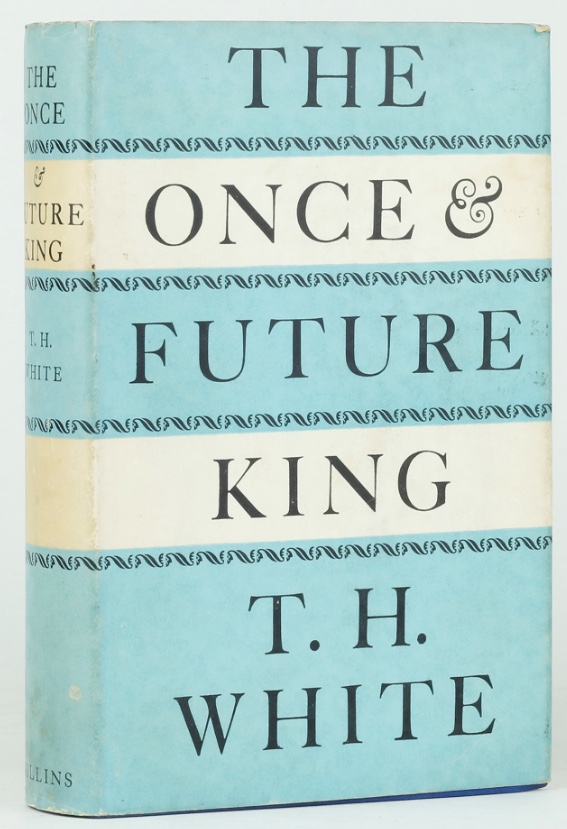The 4.04 for Forfar will leave from platform four …
Ah, that old one, the mythical announcement at Edinburgh Waverley, and in a plummy Morningside contralto. But, after a quantum of perspiration, I have arrived at …
4. T.H.White, The Once and Future King
This features here for a very particular reason. It was probably the first ‘grown-up’ novel I read and relished.
I am the man my mother made me, so I read. Christmas and birthdays guaranteed those Dent classics, as sold by Woolworths. One or two may turn up later.
I had for years plundered the ‘juvenile’ shelves of Wells branch of Norfolk Library Service. Next door but one to the post office. Both still in the same buildings. Back in my day the shelves were topped by taxidermied birds in glass cases. I see they’ve now gone for topiary in pots outside.
The old order changes …
 The day finally came when I felt the juvenilia no longer provided. I turned to the back end, S-Z, of the adult fiction shelves. And plucked out White, fresh from the press and a first-edition.
The day finally came when I felt the juvenilia no longer provided. I turned to the back end, S-Z, of the adult fiction shelves. And plucked out White, fresh from the press and a first-edition.
More than slightly timorous, I approached the check-out and presented my book and a distinctively-coloured (and I feared discriminatory) child’s card. It was accepted, without question. I shot home with 677 pages to devour (I know because I have here a copy, sadly a ‘seventh impression’ and dog-eared at that, from a school library long consigned to oblivion).
All and sundry know the first of the tetralogy — The Sword in the Stone — because Disney adapted it. But the film doesn’t do credit to the accumulated detail of White’s 1950s text (the tetralogy is an expansion of separate and simpler tales he’d written in the 1930s). By the time I reached Chapter 3, and Merlin’s cottage, with Archimedes the Owl, I was engrossed. Chapter XIII, with the Wart tranformed into an ant, and the anthill a parody of totalitarianism (and seemingly digs at Orwell), taught me early political science.
The third book in the sequence, The Ill-made Knight, has a nice analogy:
Lancelot ended by being the greatest knight King Arthur had. He was a sort of Bradman, top of the battling averages. Tristram and Lamorak were second and third.
But you have to remember that people can’t be good at cricket unless they teach themselves to be so, and that jousting was an art, just as cricket is. It was like cricket in many ways. There was a scorer’s pavilion at a tournament, with a real scorer inside it, who made marks on the parchment just like the mark for one run which is made by the cricket scorer today. The people, walking round the ground in their best frocks, from Grand Stand to Refreshment Tent, must have found the fighting very like the game. It took a frightfully long time – Sir Lancelot’s innings frequently lasted all day, if he were battling against a good knight – and the movements had a feeling of slow-motion, because of the weight of armour. When the swordplay had begun, the combatants stood opposite each other in the green acre like batsman and bowler – except that they stood closer together – and perhaps Sir Gawaine would start with an in-swinger, which Sir Lancelot would put away to leg with a beautiful leg-glide, and then Lancelot would reply with a yorker under Gawaine’s guard – it was called ‘foining’ – and all the people round the field would clap. King Arthur might turn to Guenever in the Pavilion, and remark that the great man’s footwork was as lovely as ever. The knights had little curtains on the back of their helms, to keep the hot sun off the metal, like the handkerchiefs which cricketers will sometimes arrange behind their caps today.
Knightly exercise was as much an art as cricket is, and perhaps the only way in which Lancelot did not resemble Bradman was that he was more graceful. He did not have that crouching on the bat and hopping out to the pitch of the ball. He was more like Woolley. But you can’t be like Woolley by simply sitting still and wanting to be so.
Probably today the Bradman and Woolley business wouldn’t work, but it was just right, late 1950s, for a young teen.
The Arthurian legend is the ‘matter of England’ and so part of my psyche. Whenever Tennyson and Le Morte d’Arthur cropped up in the classroom the latent Ham in me couldn’t resist —
So all day long the noise of battle roll’d
Among the mountains by the winter sea …
Bedivere fossicking around before consigning Excalibur to the lake, and the stagger down to the barge on the mere. The class would be looking at me, wondering how close to lacrimosity it took me: I was usually able to control myself:
Long stood Sir Bedivere
Revolving many memories, till the hull
Look’d one black dot against the verge of dawn,
And on the mere the wailing died away.
Gawd, but I nearly disgraced myself, again.
All that for just one book, one addition to the list — but an important one for this developing reader.
[This is the second of a sequence. As I explained earlier, I'm totally pissed with wordpress — which has been irritating me for some time. So I'm playing with a return to blogger.]





No comments:
Post a Comment